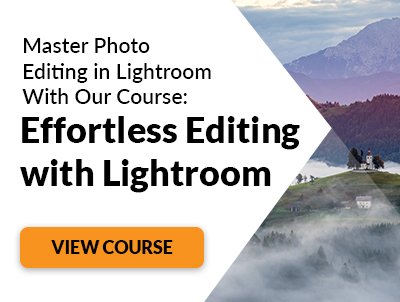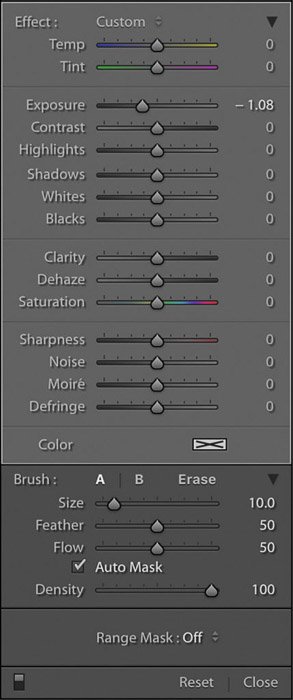How To Use Graduated Filter In Lightroom
Adobe Lightroom'due south local adjustment tools are some of its best features. The Graduated Filter is one of the tools that I use more anything else when editing landscape photography. Very few of my images brand it out of Lightroom without having practical these Lightroom filters in some manner.

The Graduated Filter is basically a Lightroom filters tool that allows you to employ the result of a concrete graduated neutral density (ND grad) filter digitally in Lightroom. ND grad filters transition from clear to night, allowing you to darken part of the epitome by placing the filter in front end of your lens when taking photos.
Being able to apply this effect in mail service-production gives you a lot more flexibility in the way the graduated filter affects your image.
At that place is more to the Graduated Filter tool in Lightroom than just darkening bright skies, though. Its uses are only express by your imagination.
I'm going to give you some Graduated Filter tips to speed up your workflow and evidence you how y'all can employ the tool more than creatively to make your mural photos look amazing.


1. Go on It Straight
In the Develop module (D), select the Graduated Filter tool (G). Place the cursor at the point of the image that you want the consequence of the filter to begin, and so drag it in any management. The transition will begin where you get-go dragging and stop where you release it.
If y'all want the filter to exist parallel to the edge of the image, try holding downwards the shift central while y'all drag the filter beyond the epitome. Belongings down shift and dragging upwardly or down volition keep the filter horizontal, dragging from the left or right will keep it vertical.
2. Edit Your Filter
One time you've created a Graduated Filter, it's non permanent. You can nevertheless drag to where you want it. Y'all can rotate it by moving the mouse over one of the lines on either side of the push button until yous see the mouse change into a rotate icon, assuasive you lot to alter the angle of the filter. Y
ou can fifty-fifty change how "hard" or "soft" the transition is by clicking and dragging one of the parallel lines that represent where the grad begins and ends.

3. View the Filter Mask
Y'all can run across the parts of the image that are afflicted past the filter by showing the mask (O). While the filter is withal active, pressing the "O" key volition show the mask.
Shift-O will change the colour of the mask, which can be helpful if the mask colour is difficult to see against the colours of the paradigm.

four. Erase Unwanted Elements
Many times when yous drag a graduated filter across an image you will include elements that yous don't want to utilize the effect to. This is one of the advantages of using the Graduated Filter tool in Lightroom rather than a physical ND grad filter, because you tin can erase the filter from the places y'all don't want it.
With the filter active, click "Brush" at the top of the panel (or Shift-T), so get to the bottom of the panel and click "Erase". You tin adjust the brush size, etc. Then, with the mask visible once again (O), brush abroad the parts of the filter where you don't want it applied.
You can also add the effect of the filter to other parts of the image the aforementioned way past following the same steps, only instead of "Erase", click on "A" or "B".
After that, castor the issue into the parts of the image that same style as if y'all were erasing some of the effect.

five. Add Colour Effects
Y'all'll notice that the Graduated Filter panel has a lot of options. The control sliders can exist used in many creative ways. One of my favourites is to add together or change the colours in my images.
Sometimes it's something every bit unproblematic as making a white rest adjustment that I only want to apply to part of the photo, merely I'll often utilize it to add a color result.
With the filter active, click on the colour box at the bottom of the graduated filter panel, so pick a colour from the chart. Movement it around the box until you detect a color that y'all like and works with the other colours in the epitome.
When you're happy with the hue, y'all can accommodate the strength of the color past adjusting the saturation slider below the color nautical chart.
It will take some experimentation, simply less is usually more with these sort of creative effects, and then don't go overboard.

6. Add together a Blur Effect
Using the sharpness slider, y'all can blur part of the prototype. Y'all might desire to do this to create a shallow depth-of-field (DOF) effect. Information technology tin can also be a great way to create a tilt-shift effect in post-production if you lot don't accept an expensive specialist lens.
If you move the sharpness slider to the left, it volition begin to mistiness the active filter. Movement it effectually until y'all go the right amount of mistiness.

7. Duplicate Your Filter
Sometimes you'll create a graduated filter upshot that you want to utilise to another function of the image. Instead of painting the effect in similar I mentioned in tip # you lot tin duplicate the filter and move it to any position you lot like.
With the filter selected, correct-click on the little circular button that you used to drag the filter across the photograph, and click indistinguishable. Now catch the push and movement information technology to wherever you'd like every bit in tip #2.
Duplicating a graduated filter can be helpful in many situations. If you desire to apply a shallow DOF effect like in tip #half dozen , you can create the filter for the top office of the prototype behind your subject, then duplicate it and move it to the bottom of the image in front of your subject area.
It's also a great way to strengthen the upshot you've created by duplicating the graduated filter and leaving it over the original to double the strength of the filter. You could fifty-fifty give one filter a soft-grad and requite the duplicate a hard-grad upshot.
You're only limited past your imagination.

Summary
You'll be surprised by the variety of ways you can apply Lightroom filters to make your photos smoothen.
The graduated filter in Lightroom is an incredibly powerful tool that can allow yous to make many artistic edits to your photos. I encourage you to dig a little deeper and accept some fun experimenting with information technology.
If you have any tips to add that I haven't mentioned, delight add together them in the comments below. I love to larn new ways to use my favourite mail service-processing tools!
Check out our article of best complimentary Lightroom presets for more than great tips!
How To Use Graduated Filter In Lightroom,
Source: https://expertphotography.com/7-tips-lightroom-graduated-filter-tool/
Posted by: calderaconere.blogspot.com


0 Response to "How To Use Graduated Filter In Lightroom"
Post a Comment